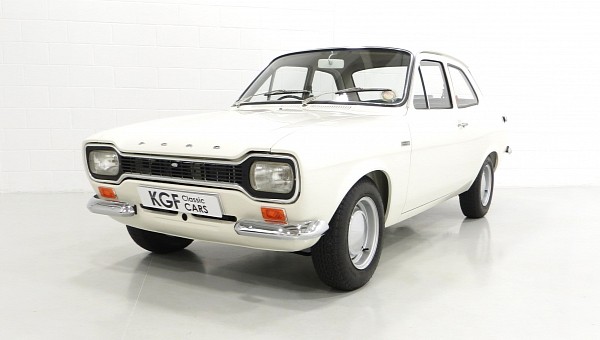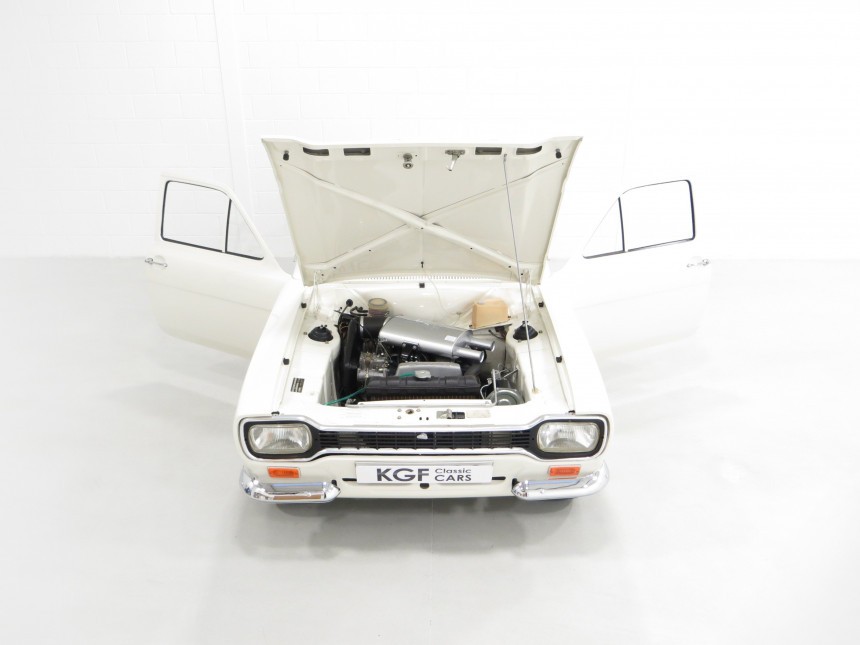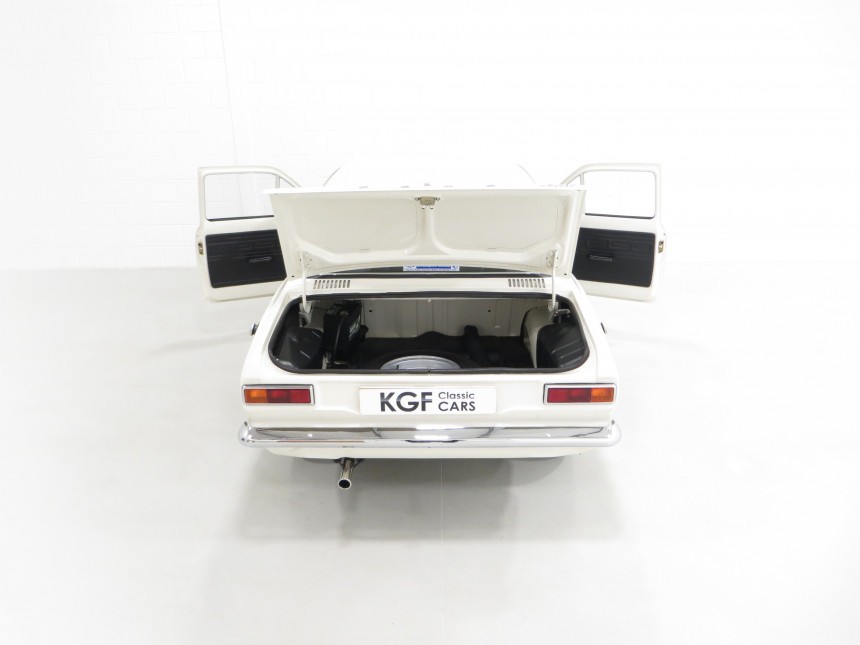Introduced in 1967 as the replacement for the Anglia, the Escort received its first RS variant in 1970 with the rollout of the RS 1600. Prior to it, the peeps at Ford of Europe imbued the small family car with some much-needed oomph in the guise of the Twin Cam that we’ll be covering today.
Henry Taylor, who made a name for himself by racing in a multitude of series, worked as Ford’s Competition Manager at the time. He had plenty of experience with the Blue Oval’s cars in rallying, having raced the Anglia, Escort, and Cortina prior to joining the Ford Motor Company in 1965. Taylor is widely considered the father of the Escort Twin Cam, which is named this way after the four-pot engine’s Lotus-designed cylinder head.
Before going any further, it should be highlighted that Rallye Sport didn’t start with the Escort RS 1600. Developed by Ford UK’s Advanced Vehicle Operations, the Escort RS 1600 can thank the Taunus 15M RS for the Rallye Sport moniker. Developed by Ford’s German division, the original is the opposite of desirable due to its underpowered V4 and FWD layout.
Turning our attention to the Twin Cam, we’re dealing with a Kent inline-four iron block topped by an aluminum cylinder head with a dual-overhead-camshaft valvetrain. The mastermind behind the Twin Cam is a gentleman by the name of Harry Mundy. The DOHC head was intended for the Pont-a-Mousson mill of the Facel Vega Facellia 1600, but financial problems at the French automaker prevented this design to reach series production. When Lotus founder Colin Chapman heard of the failed collaboration, he commissioned Mundy to adapt the eight-valve head for the Kent.
The combined efforts of many other people, including Keith Duckworth of Cosworth DFV fame, made the Twin Cam a reality. The first engine was ready for testing in October 1961, and funnily enough, the crankshaft broke due to the three-main-bearing block. The first test vehicle to receive this four-cylinder lump was an Anglia. Racing legend Jim Clark reportedly drove said test vehicle from Goodwood to his home in Scotland at speeds in excess of 100 miles per hour (make that over 160 kilometers per hour).
The 9.5:1 compression ratio, Weber carburetors, and four-into-one exhaust manifold unlocked 110 horsepower at 6,000 revolutions per minute and 107 pound-feet (145 Nm) of torque at 4,500 revolutions per minute. The 1,558-cc motor was joined by a four-speed manual transmission, namely the Type 3 2000E. A hydraulic clutch also needs to be mentioned, plus an open diff. As opposed to the FWD Taunus 15M RS, the Escort Twin Cam is RWD.
Ford of Europe switched to front-wheel drive in 1980 with the third generation, and the Escort would be discontinued in 2004 in favor of the Focus. The Escort moniker would be revived in 2015 in the Chinese market, where the Focus-based Escort is manufactured by the Changan-Ford JV.
Gifted with a 2,400-millimeter (94.5-inch) wheelbase, the Escort Twin Cam features a trunk-mounted battery. Rated at 9 imperial gallons, which is 10.8 freedom gallons or 40.9 liters, the fuel tank is located opposite to the battery. To make room for the rear carburetor, the brake master cylinder and clutch master cylinder had to be relocated. Even the transmission tunnel had to be modified. Riding lower than the Escort 1300 GT, this fellow employs 244-mm (9.6-in) front brake rotors and 229-mm (9.0-in) drums out back.
The front end of the Escort Twin Cam rocks MacPherson struts, coil springs, track control arms, and an anti-roll bar, whereas the live rear axle uses Cortina-sourced radius arms, semi-elliptic leaf springs, and telescopic dampers. Shared with the Lotus Cortina, the 13- by 5.5-inch steelies with chrome hub caps were originally mounted with Dunlop SP rubber boots.
Boasting a two-piece front bumper and black-finished front grille, the Escort Twin Cam further sweetens the deal with rectangular headlights as opposed to the circular headlights of lesser Escorts. Black vinyl upholstery, an 8,000-rpm tachometer, a speedometer that goes to 140 miles per hour (225 kilometers per hour), a heater, and two-speed wipers were standard.
Produced between 1967 and 1971, the Escort Twin Cam tips the scales at 1,731 pounds (785 kilograms). Capable of hitting 60 miles per hour (97 kilometers per hour) in the high 8-second range, the predecessor of the Escort RS 1600 tops 113 miles per hour (182 kilometers per hour). A close-ratio transmission with four forward gears was optional, as were an auxiliary fuel tank, duralumin oil sump guard, and performance exhaust.
Options further included bucket seats, an oil cooler, a high-ratio steering rack, various rear-axle ratios, a fiberglass hood and trunk lid, 6.0-inch-wide Minilite magnesium-alloy wheels, an uprated oil pump, and performance-oriented internals for the engine. What’s more, the Boreham-based Ford Performance Centre made a case for adjustable telescopic dampers for the rear end, a limited-slip differential, and performance-oriented brake pads.
Escort Twin Cam production came to a halt in 1971. No fewer than 1,263 units were produced, of which the first 883 featured rectangular headlights. The remaining 380 were originally equipped with circular headlights.
Before going any further, it should be highlighted that Rallye Sport didn’t start with the Escort RS 1600. Developed by Ford UK’s Advanced Vehicle Operations, the Escort RS 1600 can thank the Taunus 15M RS for the Rallye Sport moniker. Developed by Ford’s German division, the original is the opposite of desirable due to its underpowered V4 and FWD layout.
Turning our attention to the Twin Cam, we’re dealing with a Kent inline-four iron block topped by an aluminum cylinder head with a dual-overhead-camshaft valvetrain. The mastermind behind the Twin Cam is a gentleman by the name of Harry Mundy. The DOHC head was intended for the Pont-a-Mousson mill of the Facel Vega Facellia 1600, but financial problems at the French automaker prevented this design to reach series production. When Lotus founder Colin Chapman heard of the failed collaboration, he commissioned Mundy to adapt the eight-valve head for the Kent.
The combined efforts of many other people, including Keith Duckworth of Cosworth DFV fame, made the Twin Cam a reality. The first engine was ready for testing in October 1961, and funnily enough, the crankshaft broke due to the three-main-bearing block. The first test vehicle to receive this four-cylinder lump was an Anglia. Racing legend Jim Clark reportedly drove said test vehicle from Goodwood to his home in Scotland at speeds in excess of 100 miles per hour (make that over 160 kilometers per hour).
Ford of Europe switched to front-wheel drive in 1980 with the third generation, and the Escort would be discontinued in 2004 in favor of the Focus. The Escort moniker would be revived in 2015 in the Chinese market, where the Focus-based Escort is manufactured by the Changan-Ford JV.
Gifted with a 2,400-millimeter (94.5-inch) wheelbase, the Escort Twin Cam features a trunk-mounted battery. Rated at 9 imperial gallons, which is 10.8 freedom gallons or 40.9 liters, the fuel tank is located opposite to the battery. To make room for the rear carburetor, the brake master cylinder and clutch master cylinder had to be relocated. Even the transmission tunnel had to be modified. Riding lower than the Escort 1300 GT, this fellow employs 244-mm (9.6-in) front brake rotors and 229-mm (9.0-in) drums out back.
The front end of the Escort Twin Cam rocks MacPherson struts, coil springs, track control arms, and an anti-roll bar, whereas the live rear axle uses Cortina-sourced radius arms, semi-elliptic leaf springs, and telescopic dampers. Shared with the Lotus Cortina, the 13- by 5.5-inch steelies with chrome hub caps were originally mounted with Dunlop SP rubber boots.
Produced between 1967 and 1971, the Escort Twin Cam tips the scales at 1,731 pounds (785 kilograms). Capable of hitting 60 miles per hour (97 kilometers per hour) in the high 8-second range, the predecessor of the Escort RS 1600 tops 113 miles per hour (182 kilometers per hour). A close-ratio transmission with four forward gears was optional, as were an auxiliary fuel tank, duralumin oil sump guard, and performance exhaust.
Options further included bucket seats, an oil cooler, a high-ratio steering rack, various rear-axle ratios, a fiberglass hood and trunk lid, 6.0-inch-wide Minilite magnesium-alloy wheels, an uprated oil pump, and performance-oriented internals for the engine. What’s more, the Boreham-based Ford Performance Centre made a case for adjustable telescopic dampers for the rear end, a limited-slip differential, and performance-oriented brake pads.
Escort Twin Cam production came to a halt in 1971. No fewer than 1,263 units were produced, of which the first 883 featured rectangular headlights. The remaining 380 were originally equipped with circular headlights.


































